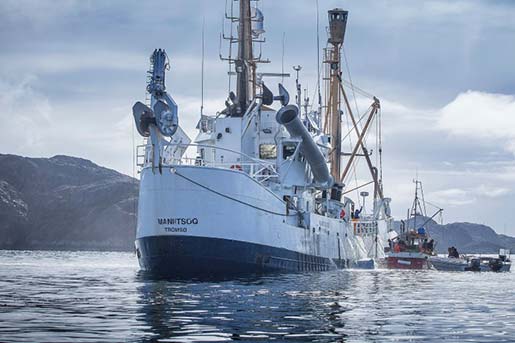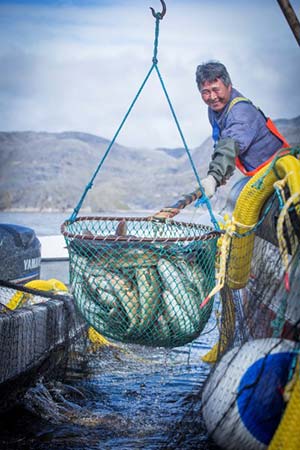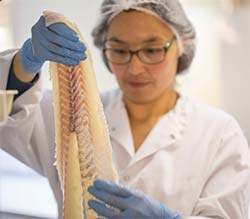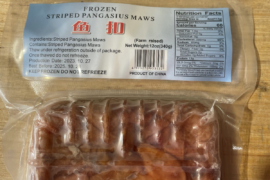The Royal Greenland marketing team calls it “Nutaaq,” which is Greenlandic for “new” – to denote an exceptional new quality standard for Atlantic Cod (Gadus morhua). The fish, which goes from the water to the freezer within a maximum of two hours, has flesh that is almost translucent and perfectly lean prior to cooking, thanks to stringent quality control and expert trimming by hand.
The natural flavor and moisture of the cod is locked in, due to exceptionally rapid post-harvest processing. After packing, the fish is stored in the factory’s refrigerated warehouse at -23°C before later being dispatched to quality-conscious customers around the world.
The Nutaaq concept was developed in cooperation with fishermen in Western Greenland. Cod harvested from the local waters have firm white meat and a slightly sweet flavor attributed to the cold, clean environment in which they grow more slowly than elsewhere.
The quality of any given cod product depends on just a few things: the origin and habitat of the fish, and employment of gentle yet rapid processing technology.
Fishing for Nutaaq cod takes place for only a few months each year, between April and October, when grown cod leave the open sea and enter the shallow waters along the Greenlandic coast to spawn. There fishermen place traps next to rocky outcrops so that the fish is lured into the nets with little possibility of escape. This is an ancient and low-impact fishing method that is selective, as well as environmentally friendly.
 The well-boat seen at right is carefully scooping the live fish on board, directly from the fisherman’s net.
The well-boat seen at right is carefully scooping the live fish on board, directly from the fisherman’s net.
When the net is full, Royal Greenland well-boats collect the live fish. They are lifted in small net baskets from the fisherman’s net and onto the larger well-boat. Once on board, the cod is quickly sorted and any under-sized fish below a length of 40 centimeters are returned to the sea alive so that may continue to reproduce and contribute to the future cod stocks.
 This just-caught cod will be taken to seawater pools near the freezing plant for an overnight stay prior to processing the following day or thereafter.The well-boat then transports the larger cod safely in seawater pools that are just a short distance from the factory. Here, the fish are kept in a stress-free pond environment until processing lines are ready to receive them. They always remain overnight in these calm conditions, as stress-free fish yield premium meat quality.
This just-caught cod will be taken to seawater pools near the freezing plant for an overnight stay prior to processing the following day or thereafter.The well-boat then transports the larger cod safely in seawater pools that are just a short distance from the factory. Here, the fish are kept in a stress-free pond environment until processing lines are ready to receive them. They always remain overnight in these calm conditions, as stress-free fish yield premium meat quality.
When the time is right, the live cod literally swim into the factory. A slow-moving barrier onto a belt and into the plant gently pushes them. Thereafter they are stunned, then quickly slaughtered and bled in ice-cold water, making sure that all blood leaves the flesh immediately. This results in uniform quality and guarantees that there are no red spots.
Next the cod are cleaned, headed, gutted and filleted pre-rigor in one mechanical process, and then trimmed by hand. An experienced trimming team scrutinizes every fillet for red spots or gaps. If detected, the fillet in question will not be graded as Nutaaq.
 A Royal Greenland quality control specialist carefully checks this Atlantic Cod fillet before it is frozen and packed.Royal Greenland’s Atlantic Cod products are available in various cuts, and the fish is either sold whole or cut into fillets, with or without skin and bones. Alternatively, the fish is divided into loins with or without skin, and portions without skin. The Atlantic cod is also available as convenient ready meals in breaded, battered or marinated form.
A Royal Greenland quality control specialist carefully checks this Atlantic Cod fillet before it is frozen and packed.Royal Greenland’s Atlantic Cod products are available in various cuts, and the fish is either sold whole or cut into fillets, with or without skin and bones. Alternatively, the fish is divided into loins with or without skin, and portions without skin. The Atlantic cod is also available as convenient ready meals in breaded, battered or marinated form.
The Atlantic Cod species lives mainly in the North Atlantic Sea and the Barents Sea. The fish is easily recognizable by the characteristic beard on the jaw and speckled skin that changes color, depending on the bottom conditions in its living area. It typically lives near the bottom at depths of between 50 and 200 meters and has a strong preference for water temperatures of around 2-10°C. The cod is not a picky eater and around Greenland it mainly preys on Capelin and coldwater prawns. It is even known to eat smaller members of its own species, making it a true omnivore.





